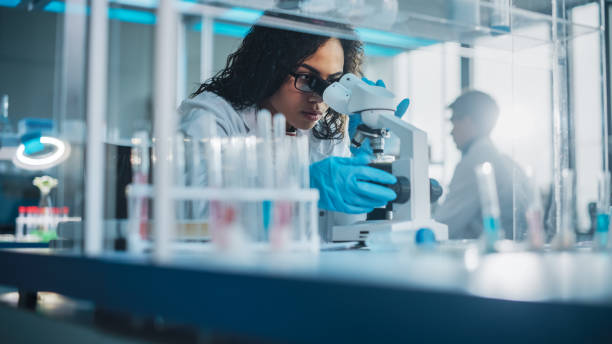Modern Medical Laboratory Innovations: A Comprehensive Guide to Advancements in Lab Equipment
The medical laboratory landscape has transformed dramatically in recent years, with technological breakthroughs revolutionizing diagnostic capabilities and research potential. Modern laboratories now utilize sophisticated equipment that enhances accuracy, efficiency, and accessibility of crucial medical tests. These innovations have fundamentally changed how healthcare professionals detect diseases, monitor treatments, and conduct research. As laboratories continue to evolve, understanding the latest equipment advancements becomes essential for healthcare facilities seeking to provide cutting-edge patient care and research capabilities.

How Have Laboratory Diagnostic Devices Evolved in Recent Years?
Laboratory diagnostic devices have undergone remarkable evolution, moving from manual, time-consuming processes to automated, high-precision systems. Modern analyzers can now process hundreds of samples simultaneously, delivering results in minutes rather than hours or days. Molecular diagnostic platforms have advanced to provide point-of-care testing options, allowing for rapid diagnosis of infectious diseases like COVID-19, influenza, and bacterial infections.
The integration of artificial intelligence and machine learning has enabled equipment to identify patterns and anomalies in test results that might escape human detection. For example, hematology analyzers now use advanced algorithms to flag abnormal cell populations, potentially identifying leukemia or other blood disorders earlier. Similarly, next-generation sequencing platforms have dramatically reduced both the cost and time required for genetic analysis, making personalized medicine increasingly practical in clinical settings.
What Are the Most Revolutionary Advancements in Medical Lab Technology?
Among the most transformative advancements in medical laboratory technology are digital pathology systems that enable pathologists to examine tissue samples remotely with unprecedented detail. These systems use high-resolution scanners to create digital slides that can be analyzed using sophisticated software, potentially improving diagnostic accuracy while reducing turnaround times.
Mass spectrometry has evolved from a research-only tool to a clinical laboratory staple, offering unparalleled sensitivity in detecting biomarkers, therapeutic drugs, and metabolites. Modern mass spectrometers can identify thousands of compounds in a single sample, revolutionizing toxicology screening, newborn testing, and therapeutic drug monitoring.
Liquid biopsy technology represents another groundbreaking innovation, allowing detection of circulating tumor DNA, cells, or exosomes from a simple blood draw. This minimally invasive approach can potentially detect cancer earlier, monitor treatment response, and identify drug resistance mutations without requiring tissue biopsy. Companies like Guardant Health and GRAIL have developed tests that can detect multiple cancer types from a single blood sample, potentially revolutionizing cancer screening protocols.
How Is Automation Transforming Laboratory Workflows?
Laboratory automation has fundamentally transformed workflow efficiency, reducing human error while enhancing throughput capacity. Total laboratory automation (TLA) systems now connect pre-analytical, analytical, and post-analytical processes into seamless workflows. These systems can automatically uncap tubes, centrifuge samples, aliquot specimens, run tests, and archive samples without human intervention.
Robotic systems have become increasingly sophisticated, handling delicate procedures like liquid handling, cell culture maintenance, and compound screening with precision that exceeds human capability. The integration of track systems that transport samples between different instruments has eliminated manual transfer steps, reducing contamination risks and improving sample tracking.
Laboratory information systems (LIS) and middleware solutions have evolved to manage the enormous data output from automated equipment, providing real-time analytics and facilitating remote monitoring of laboratory operations. This connectivity enables laboratories to operate 24/7 with minimal staffing while maintaining quality standards. Additionally, automated verification algorithms can flag abnormal results for pathologist review while automatically releasing normal results, significantly reducing result turnaround times.
What Miniaturized and Point-of-Care Technologies Are Changing Diagnostics?
Miniaturization has dramatically expanded point-of-care testing capabilities, bringing sophisticated diagnostics directly to patient care settings. Handheld devices now offer capabilities previously available only in centralized laboratories. Examples include portable blood analyzers that can measure complete blood counts, basic metabolic panels, and cardiac markers within minutes at the bedside.
Microfluidic “lab-on-a-chip” technologies represent a particularly exciting development, integrating multiple laboratory functions on a single chip measuring only millimeters to a few square centimeters. These devices require minimal sample volumes while delivering rapid results, making them ideal for resource-limited settings or emergency situations. Companies like Abbott and Roche have developed portable molecular diagnostic systems that can detect infectious diseases with accuracy comparable to central laboratory testing.
Wearable diagnostic technologies are further extending laboratory capabilities beyond traditional settings. Continuous glucose monitors have revolutionized diabetes management, while emerging wearable sensors can now detect biomarkers in sweat, tears, or interstitial fluid. Research is advancing on smartwatch technologies capable of detecting cardiac arrhythmias, oxygen saturation, and even early signs of respiratory infections.
How Are Precision Medicine Tools Reshaping Laboratory Testing?
Advanced laboratory equipment supporting precision medicine has transformed personalized patient care approaches. Next-generation sequencing platforms have evolved to deliver comprehensive genomic profiling at increasingly affordable costs, enabling clinicians to identify specific genetic variants that influence disease risk and treatment response. These systems can now sequence an entire human genome in under a day, compared to years required by earlier technologies.
Digital PCR systems offer unprecedented sensitivity for detecting rare mutations or gene variations, critical for monitoring minimal residual disease in cancer patients or detecting fetal DNA in maternal blood samples. Flow cytometry has similarly evolved with spectral cytometry systems now capable of analyzing more than 40 parameters simultaneously on individual cells, revolutionizing immunophenotyping for immune disorders and cancers.
Pharmacogenomic testing platforms enable laboratories to identify genetic variations affecting drug metabolism, helping clinicians select optimal medications and dosages for individual patients. This approach reduces adverse drug reactions while improving treatment efficacy across numerous clinical specialties. Companies like Illumina, Thermo Fisher, and Oxford Nanopore continue driving innovation in this space, developing increasingly accessible and powerful platforms for genetic analysis.
What Equipment Is Essential for a Modern Medical Laboratory?
The foundation of any contemporary medical laboratory includes several core equipment categories that have seen significant technological advancement. Modern clinical chemistry analyzers form the backbone of routine testing, processing hundreds of samples hourly while maintaining exceptional precision. Leading systems from manufacturers like Roche, Abbott, and Siemens incorporate immunoassay capabilities, allowing comprehensive testing on a single platform.
Molecular diagnostic equipment has become essential, with PCR systems, sequencers, and extraction platforms now standard in most hospital laboratories. These systems enable infectious disease detection, genetic testing, and oncology diagnostics with unprecedented speed and accuracy. Advanced microscopy equipment remains fundamental but has evolved dramatically with digital imaging capabilities, automated cell counting, and AI-assisted analysis.
A comparison of essential modern laboratory equipment systems reveals significant differences in capabilities and applications:
| Equipment Type | Representative System | Key Capabilities | Typical Applications |
|---|---|---|---|
| Chemistry/Immunoassay | Roche Cobas Pro | Up to 2,000 tests/hour, 50+ assay menu | Routine blood chemistry, cardiac markers, hormone testing |
| Molecular Diagnostics | Cepheid GeneXpert | 30-120 min results, multiplexed PCR | Infectious disease detection, oncology testing |
| Hematology Analyzer | Sysmex XN Series | 100+ samples/hour, automated cell differentiation | Complete blood counts, blood disorder screening |
| Mass Spectrometry | SCIEX Triple Quad 7500 | Femtogram-level sensitivity, rapid analysis | Therapeutic drug monitoring, newborn screening |
| Digital Pathology | Philips IntelliSite | Whole slide imaging, AI-assisted analysis | Cancer diagnosis, telepathology consultation |
Prices, rates, or cost estimates mentioned in this article are based on the latest available information but may change over time. Independent research is advised before making financial decisions.
Medical laboratories continue evolving rapidly, with emerging technologies promising even greater diagnostic capabilities. The integration of artificial intelligence with traditional equipment is enhancing diagnostic accuracy while uncovering previously undetectable patterns in test results. As laboratories navigate this changing landscape, strategic equipment selection becomes increasingly critical for delivering precision diagnostics that directly impact patient outcomes and advance medical research capabilities.
This article is for informational purposes only and should not be considered medical advice. Please consult a qualified healthcare professional for personalized guidance and treatment.



